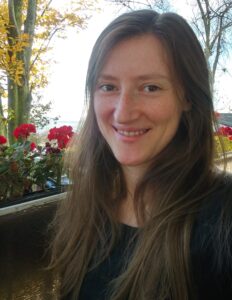Janka Bauer
 PhD Student
PhD Student
Associate member of the GRK2516
Group: Dr. Arash Nikoubashman, JGU Physics
Contact: E-mail
Research Project: Theory
Intrinsically disordered proteins (IDPs) play an integral part for the formation of membraneless organelles in cells via liquid-liquid phase separation, which in turn have key functional and regulatory roles. Mutations in the sequence of amino acids can alter the conformation, dynamics, and phase behavior of the respective IDPs, which can disrupt their functionality and lead to the emergence of severe diseases such as cancer and amyotrophic lateral sclerosis. We seek to establish a better understanding of the underlying processes by using coarse-grained implicit solvent molecular dynamics simulations [1] to study selected IDPs in bulk solutions and confined environments.
We studied the impact of varying the fraction of aromatic residues within the sequence of the IDP A1-LCD. Our simulation results strongly support previous experiments that identified aromatic residues as a driving force for phase separation, and we found a significant compaction of the chains in the dilute phase and an increase in the critical temperature with increasing number of aromatic residues [2].
To mimic more closely conditions prevalent in cellular environments, we performed coarse-grained molecular simulations of A1-LCD and FUS in spherical confinement, where we systematically varied the fraction of the crowding agent polyethylene glycol (PEG). We further cross-linked the PEG chains to create a viscoelastic network to study resulting limitations in the size and mobility of the protein condensates (Fig. 1).

References:
[1] Gregory L. Dignon , Wenwei Zheng , Young C. Kim, Robert B. Best, Jeetain Mittal, PLOS Computational Biology 14(1): e1005941 (2018)
[2] D. Janka Bauer, Lukas S. Stelzl, Arash Nikoubashman, J. Chem. Phys. 157, 154903 (2022).
